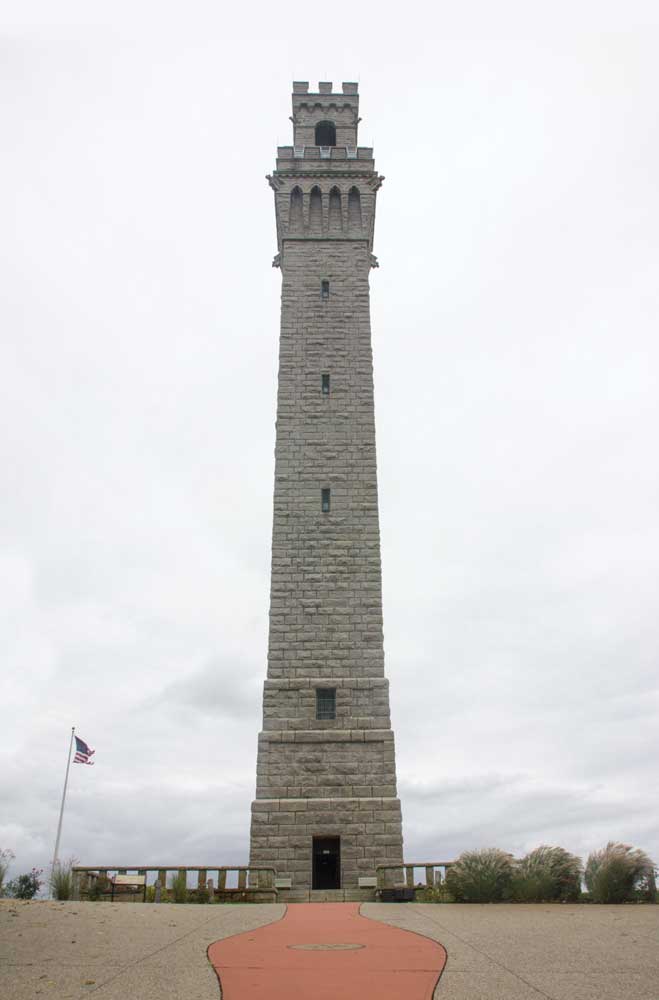Fun, facts, fine art and cranberries in the Bay State
It’s no secret that Massachusetts has a rich history. Its residents are proud of their state, and have found compelling ways to tell its stories. Who knew history could be so engaging?
My husband, Jim, and I started our journey through Massachusetts with two nights at the Boston Minuteman Campground (open May-October) in Littleton, with street names like Redcoat Lane and Patriot Circle. Our site backed up to a picturesque forest. The campground is 30 miles northwest of Boston, and the owners advised us on transportation options to the big city. We drove our dinghy to the Riverside Massachusetts Bay Transit Authority (MBTA) parking lot to catch a subway into Boston. This parking lot can also accommodate motorhomes.
At the Boston Common Visitor Center, we met our guide for the Walk Into History tour. All of the tour guides dress as specific 18th-century characters. Ours was Mercy Otis Warren, a political writer during the American Revolution, a profession that was highly unusual for a woman at that time. Mercy led us to 11 of 16 historic sites on the Freedom Trail. Boston Common, established in 1634, is America’s oldest park. It’s been used as a pasture to graze livestock, a site for executions and puritanical punishments, a training field for British soldiers and a site for public assembly. Granary Burying Ground is the final resting place for many notable Bostonians including John Hancock, Paul Revere and Samuel Adams. At the Boston Massacre Memorial, a ring of cobblestones marks the spot where five civilians were killed by British soldiers in 1770. The first floor of Faneuil Hall became a center of commerce in 1742. On the second floor, speeches were given promoting freedom and liberty. In 1764 Americans gathered there to protest the Sugar Act and the Stamp Act, declaring “No taxation without representation.”
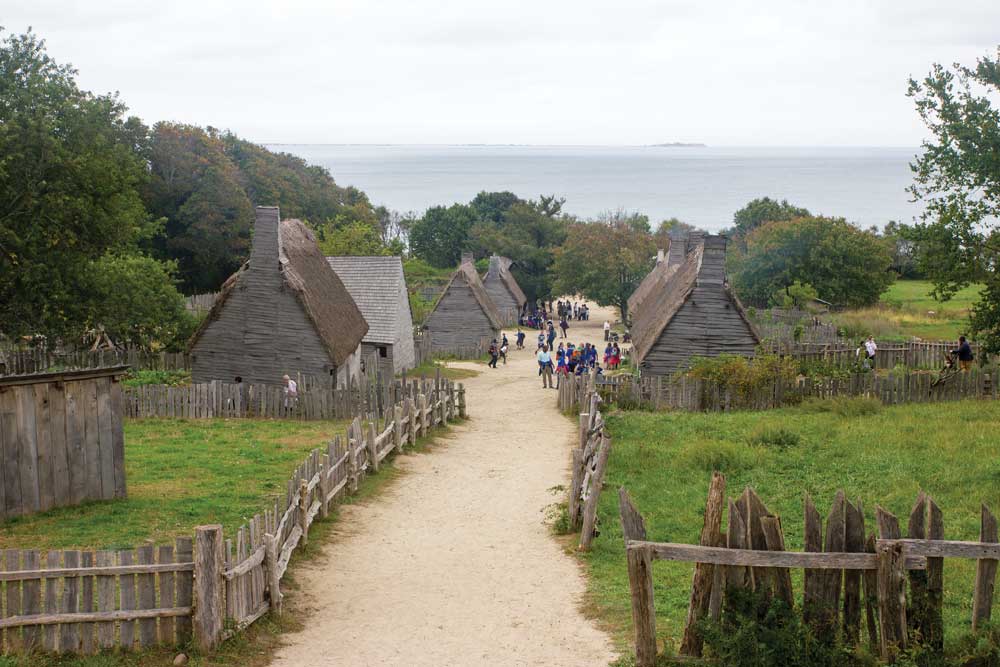
From the second floor of the meeting house in Plimoth Plantation, we could see the entire 17th-century English Village, a re-creation of the community built by the Pilgrims along the shore of Plymouth Harbor.
After our tour, we had lunch at Cheers, a replica of the bar in the TV show where “Everybody knows your name.” Even though the bartender didn’t look a bit like Sam and our waitress was much nicer than Carla, the setting made us feel nostalgic for the familiar show.
Uncommon Boston Common
The oldest park in the U.S. has been the site of free speech and public assembly for nearly 400 years. Presidents George Washington and John Adams came here to celebrate the nation’s independence. Civil War recruitment — and anti-slavery meetings — were hosted here. Some 20th century highlights include Charles Lindbergh promoting commercial aviation, Martin Luther King Jr. holding a civil rights rally and Pope John Paul II celebrating Mass in 1979.
We took the subway to Harvard University for a tour of our nation’s oldest university, established in 1636. Our tour guide told us the history of notable buildings. Massachusetts Hall is the oldest surviving building, and dormitory to famous alumni including John Adams, John Hancock and Samuel Adams. In Weld Hall, legend has it that overwhelming demand for the room that housed John F. Kennedy during his freshman year prompted officials to locate the elevator shaft in that space when the building was remodeled.
We had some time before the next subway back to our campground. We went to the Beantown Pub, right across from the Granary Burying Ground. It’s “the only pub in the world where you can drink a Sam Adams while viewing the grave of Sam Adams.” Jim was happy to seize the unique opportunity.
Pinewood Lodge Campground (open May to Columbus Day) in Plymouth served as our base camp for the next four nights. The campground’s 300 sites are nestled in 200 acres of white pine forest. I’m admitting this only to let you know how big the RV park is: I got lost one night coming home from the laundry room.
On our first afternoon in Plymouth, we biked on the paved 22-mile Cape Cod Rail Trail, starting at the South Dennis Trailhead. We rode through heavily wooded areas, with occasional glimpses of open water and cranberry bogs. The trail passes through six towns.
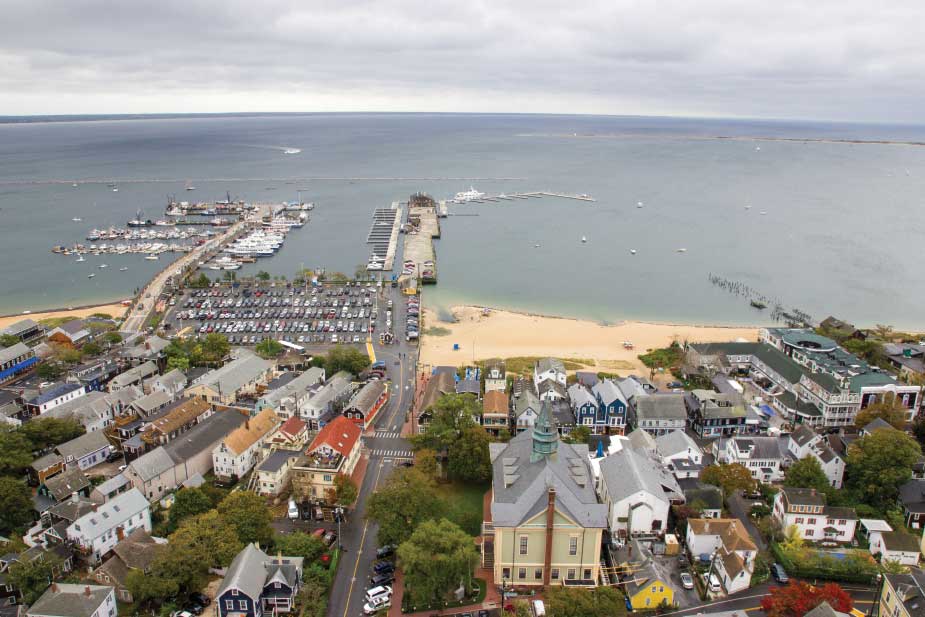
Visitors to the top of the Pilgrim Monument are treated to a 360-degree view of the surrounding area.
The next morning we arrived at Plimoth Plantation at the same time as bus loads of children on field trips. Their enthusiasm for learning was infectious. We followed them to the Wampanoag Homesite. The Wampanoag, a Native American tribe, lived nearby at the time of first contact with English colonists. Shortly before the Pilgrims arrived in 1620, the Wampanoag suffered an epidemic between 1616 and 1618 that decimated their population. Researchers speculated that French traders introduced a disease the tribe had no immunity to. Losses to their population may be one reason the Colonists were able to establish the Massachusetts Bay Colony more easily.
Wampanoag descendants were building a canoe the traditional way, by burning away the interior of a large white pine log. Our timing was perfect since they do this twice a year, in the spring and fall. The fire burns for a week, tended day and night.
Plimoth Plantation also has a 17th-Century English Village, a re-creation of the community built by the Pilgrims along the shore of Plymouth Harbor. From the second floor of the meeting house, we could see the entire village with its modest timber-framed houses. The meeting house also doubled as a fort, with several cannons for protection. After wandering through the one-room houses, we encountered a costumed character in the role of Myles Standish.
No trip to Plymouth would be complete without a visit to Plymouth Rock. According to legend, it’s the site where the Pilgrims disembarked from the Mayflower. The rock wasn’t mentioned in any writings, but 121 years later Elder Thomas Faunce made that claim, and it’s been famous ever since. After being moved to Pilgrim Hall Museum, broken, and chipped by souvenir hunters, it’s about half of its original size. It now sits on the shore of Pilgrim Memorial State Park, inscribed with the year 1620 beneath a granite canopy.
After dark we went back to Plymouth Rock to meet our tour guide, Bob, next to a gray hearse. We picked up our kerosene lanterns and set out on the Dead of Night Ghost Tours 90-minute Twilight Lantern Ghost Tour. Bob led us through several haunted locations, including Burial Hill (where the Pilgrims began burying their dead in the 1620s), the site of the original Plymouth settlement, the old Town Square and the First Parish Church. Bob told us about famous ghosts. The youngest was 8-year-old Abigail, who died of an abscessed tooth. Sally Robinson fell from a carriage on her wedding day. We were encouraged to take photos in the hopes of capturing some ghostly images in the empty spaces surrounding the headstones. One woman who said she didn’t believe in ghosts showed the group a photo she took of what appeared to be a little boy peeking out from behind a headstone. The tours are a popular attraction year-round, weather permitting. In mid-October, it was the perfect way to get in a spooky mood for Halloween. Dead of Night Ghost Tours also offers a combo tour that includes admission to two historic haunted houses. Plan ahead if you want that one since it frequently sells out.
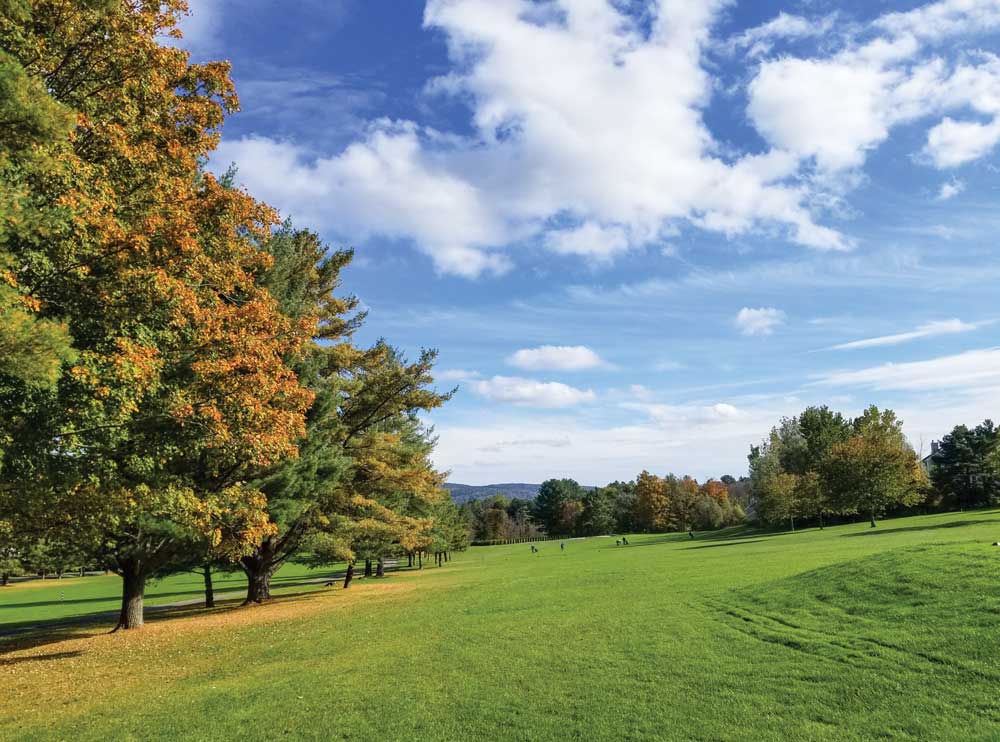
Golf Digest named the 18-hole golf course at Cranwell Resort in Lenox one of the “Best Places to Play.”
We spent a full day in Provincetown, known as P-Town to locals. It’s a small coastal resort town at the tip of Cape Cod. At the Pilgrim Monument and Provincetown Museum, visitors can learn about the town’s history, including what the Pilgrims did during their five weeks on Cape Cod before departing for Plymouth. From the top of the Pilgrim Monument, the tallest all-granite structure in the U.S. at a height of more than 252 feet, I had a 360-degree view of the town.
On Art’s Dune Tour, we rode in a Suburban to the protected dunes of the Cape Cod National Seashore. Only dune tour guides and shack dwellers can drive on the sandy road that winds though the rolling windswept landscape of the Dune Shacks of Peaked Hill Bars Historic District. The 1,950-acre district was listed in the National Register of Historic Places in 2012 due to its significance for art and literature. Nineteen shacks were home to artists and writers from the 1920s to present day. Playwright Eugene O’Neil, poet Harry Kemp, and painter Jackson Pollock are a few of the American artists who have found inspiration and solitude in the dune shacks. Since the mid-1990s, the National Park Service has worked with nonprofits that offer artist-in-residence and writer-in-residence programs. These primitive shacks don’t have electricity or indoor plumbing.
When I started planning our trip, the activity I was most excited about was a cranberry bog tour. Mayflower Cranberries is a 112-acre farm with 23.6 acres of active cranberry bogs in Plympton. Jeff and Kim LaFleur are grower-owners for Ocean Spray Cranberries, a farmer-owned cooperative. We signed up for their “Be the Grower” program so we could be like the guys in the TV commercials. Jeff explained the bog to be harvested was flooded with up to 18 inches of water the previous day, and a rotating water wheel removed the cranberries from the vines. The cranberries were then corralled by a large boom. That’s when the temporary workforce of up to 10 people enrolled in the “Be the Grower” program got involved. We donned waders and sloshed around knee-deep in cranberries to assist the real farmers in the wet harvest. We used rakes to push the floating cranberries toward a suction system that delivered them to a dump truck. Within an hour, the truck was filled and we were relieved of our duties. If this sounds like fun to you, make your reservations well in advance. Mayflower also offers an “Adopt-A-Bog” program where participants dry harvest a 100-square-foot plot using a wooden scoop, which yields 30 pounds of fresh cranberries. Be sure to contact the farm before visiting; according to the website, Mayflower Cranberries is not open for tours in 2019.
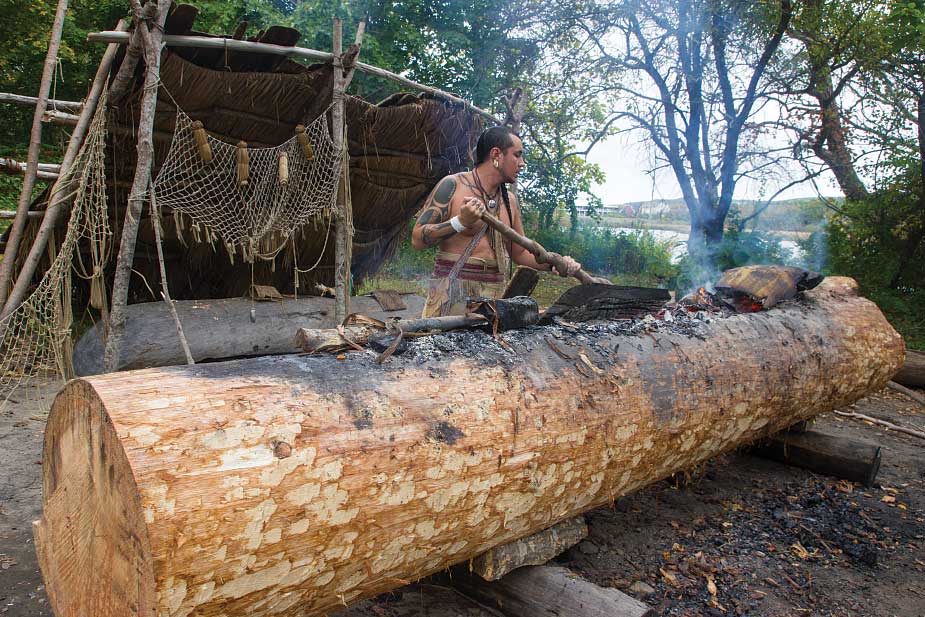
At the Wampanoag Homesite, descendants build canoes the traditional way, by burning away the interior of a large white pine log.
Since we wanted to experience the Berkshire Mountains in western Massachusetts, we moved to Mt. Greylock Campsite Park in Lanesborough for our last two days. The RV park sits at the base of Mount Greylock, the highest peak in the state. The 40-acre park has more than 100 large sites. I was impressed by the owner’s commitment to recycling, giving recycling bags to guests when they check in.
The nearby Cranwell Resort in Lenox has an 18-hole golf course. Golf Digest named it one of the “Best Places to Play.” It’s a beautiful course, with the trees lining the fairways just starting to show their fall colors. The entire resort has been undergoing a refurbishment; visit the website for details.
The Massachusetts Museum of Contemporary Art, or Mass MoCA, is housed in a converted factory building complex in North Adams. It features “large-scale immersive installations that would be impossible to realize in conventional museums.” With 250,000 square feet of gallery space, they can do that. In The Archaeology of Another Possible Future, artist Liz Glynn examines “the shift from a material-based economy to one in which technology companies seem to generate billion-dollar valuations out of thin air.” The five-part installation covers 30,000 square feet. In Laurie Anderson’s virtual-reality (VR) installation, The Chalkroom, I put on a VR headset and seemed to float past rooms and buildings covered with chalk drawings. At Anish Kapoor’s mirrored, abstract sculpture, I took a splintered selfie in which I have 11 eyes. Even though it’s called a museum, Mass MoCA devotes half of its resources to the performing arts, with more than 75 performances a year. Exhibitions rotate in and out, so check the website before visiting.
Rudyard Kipling said, “If history were taught in the form of stories, it would never be forgotten.” Our story-telling tour guides did a great job of relating unforgettable tales of the last 400 years. And at Mass MoCA, we had an opportunity to ponder the future.
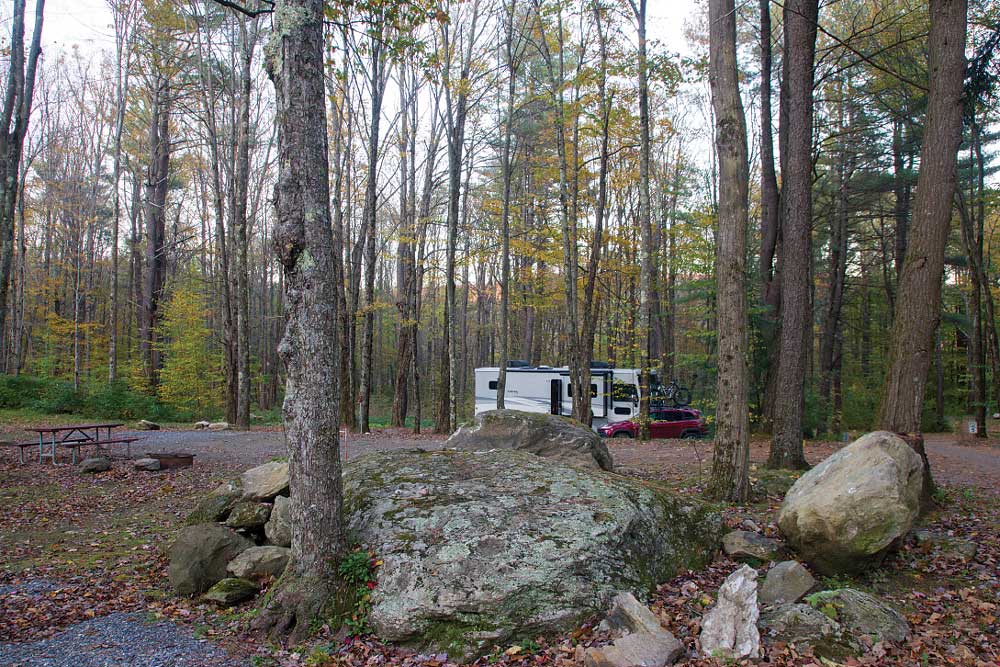
Mt. Greylock Campsite Park in the Berkshires sits at the base of Mount Greylock, the highest peak in the state.

